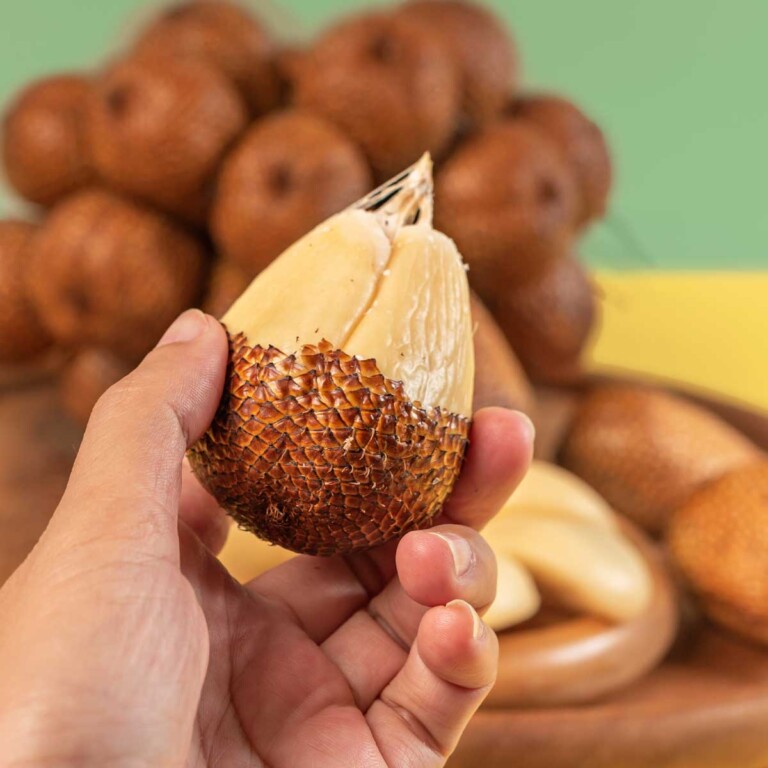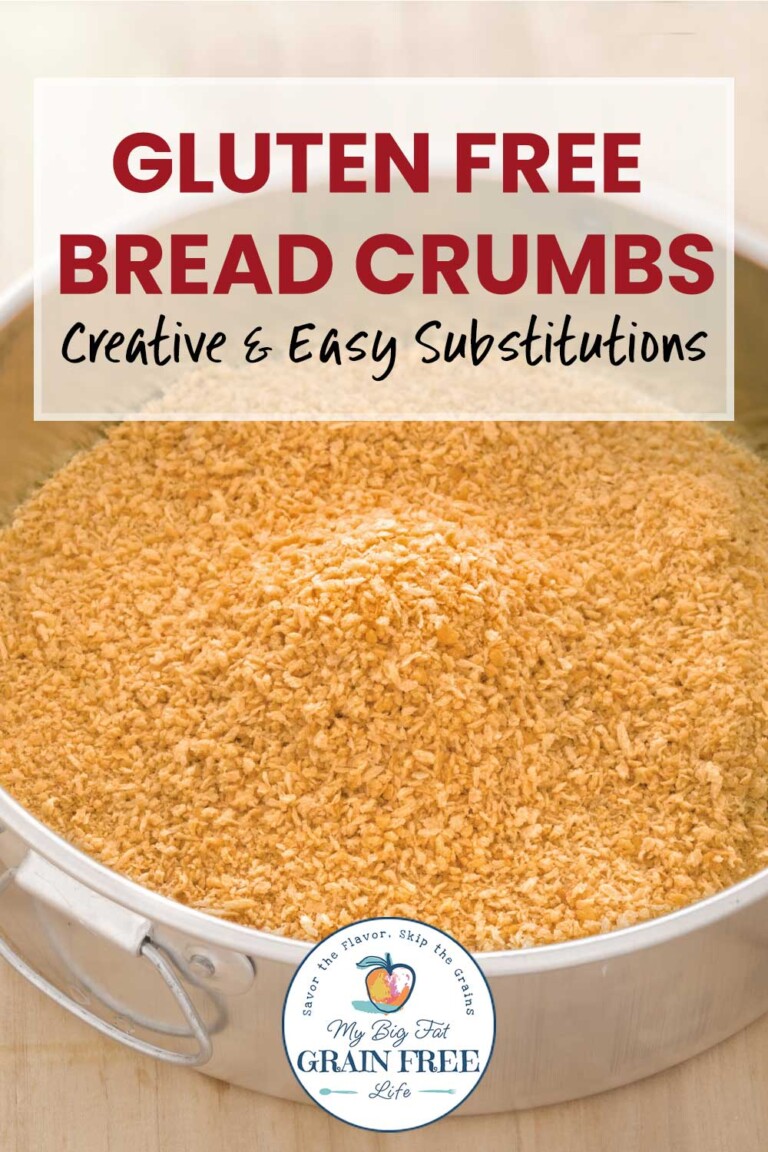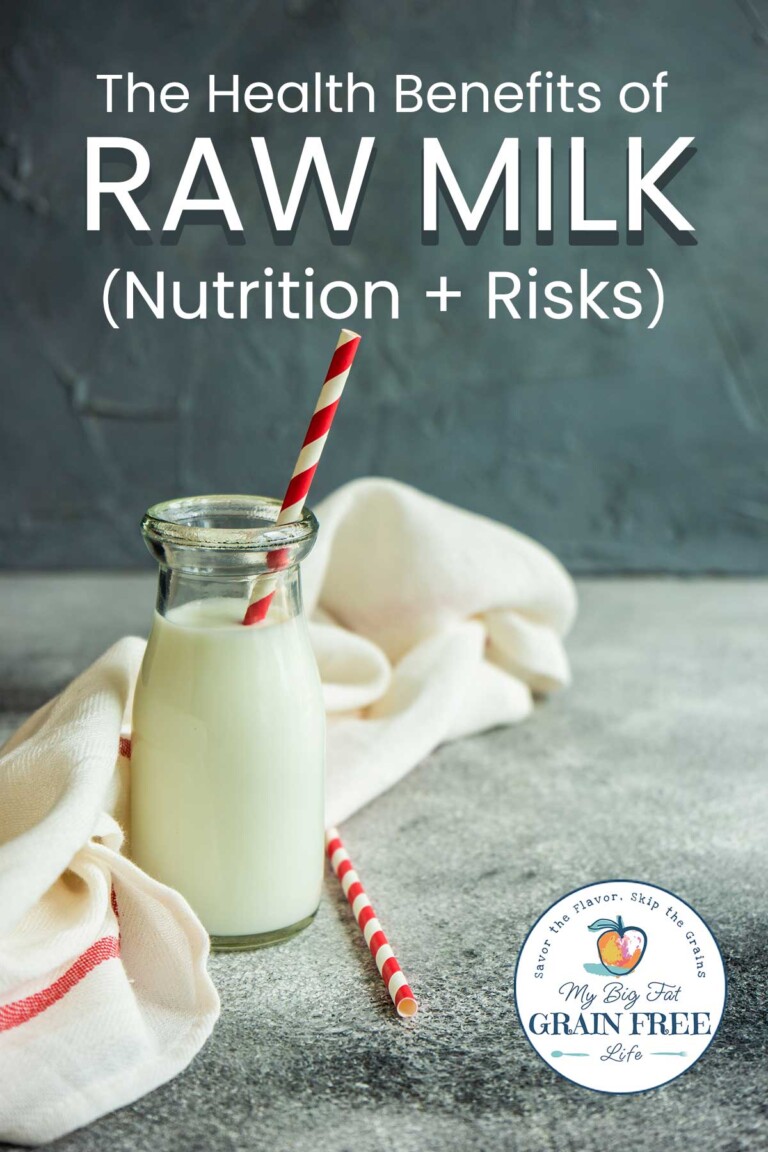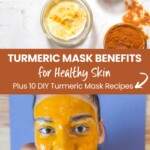Turmeric Mask Benefits for Healthy Skin (10 DIY Recipes)
This post may contain affiliate links. If you make purchase after clicking a link, I may receive a commission at no extra cost to you.
Last Updated on April 16, 2024
Maybe you’ve heard about the health benefits of turmeric as part of a healthy diet, but did you know it’s good for your skin too? Learn about turmeric mask benefits and different ingredients you can combine to help all sorts of skin conditions.

Turmeric Mask Benefits
There are some serious benefits of turmeric masks, and they are worth making a part of your skincare routine. Turmeric itself has healing properties and has been used for a long time in ayurvedic medicine.
The major skin benefits of turmeric masks are due to the anti-inflammatory properties and antioxidant effects that can help soothe dry and irritated skin, reduce inflammation, and bring out a natural glow.
You can combine turmeric with other ingredients for different skin issues. You can find 10 recipe variations for homemade turmeric masks below the health benefits.
Turmeric Skincare
With its numerous benefits for the skin, it is no wonder that people are turning to turmeric as a key ingredient in their skincare routines.

Health Benefits of Turmeric Masks
Its powerful anti-inflammatory properties make turmeric a valuable ingredient in facial masks for combating skin conditions such as acne, eczema, and psoriasis. Additionally, turmeric is rich in antioxidants that help protect the skin from environmental damage and signs of aging.
You can also use turmeric masks to help to even out skin tone and reduce the appearance of dark spots and hyperpigmentation. But there’s more! Learn about all the turmeric masks benefits below.
Exhibits Antimicrobial Properties
The active compound in turmeric, called curcumin, exhibits strong antibacterial and antifungal effects. When applied as a mask on the face, turmeric can help reduce the growth of acne-causing bacteria and prevent skin infections.
Contains Anti-inflammatory Properties
Turmeric contains curcumin, which has strong anti-inflammatory effects, helping to reduce redness and swelling on the face.
Helps Fight Acne
The antibacterial properties of turmeric can help fight acne-causing bacteria and reduce breakouts in acne-prone skin.
Can Brighten Skin Tone
Regular use of turmeric masks can help even out skin tone and give a natural glow to the face.
Helps Fades Dark Spots
Turmeric has been found to fade hyperpigmentation and dark spots, resulting in a more even complexion.
Reduces Signs Of Aging
The antioxidant properties of turmeric can help protect the skin from free radicals, reducing the appearance of fine lines and wrinkles.
Soothes Dry Skin
Turmeric masks are moisturizing and can provide relief to dry and flaky skin.
Can Lighten Facial Hair
Regular application of turmeric masks can help lighten unwanted facial hair over time.
Exfoliates Dead Skin Cells
Turmeric acts as a gentle exfoliant, removing dead skin cells and revealing smoother, brighter skin.

Helps Minimize Pores
Turmeric helps tighten pores, reducing their appearance and giving the skin a smoother texture.
Improves Complexion
Regular use of turmeric masks can improve overall complexion by reducing dullness and promoting a healthy glow.
Helps Soothe Eczema And Psoriasis
The anti-inflammatory properties of turmeric may provide relief from symptoms associated with eczema and psoriasis.
Anti-aging Effects
Turmeric stimulates collagen production, promoting elasticity in the skin and reducing sagging or loose skin.
Provides Some Natural Sunscreen Protection
Studies suggest that applying turmeric topically may offer some protection against harmful UV rays.
Helps Calm Sensitive Skin
Turmeric has soothing properties that can calm irritated or sensitive skin conditions like rosacea.
Reduces Under-eye Dark Circles
The anti-inflammatory and skin-brightening properties of turmeric can help reduce the appearance of dark circles under the eyes.
Enhances Wound Healing
Turmeric has been used for centuries to promote wound healing and prevent infection.
Boosts Skin Immunity
The antioxidant properties of turmeric help strengthen the skin’s natural defense against environmental damage.
Balances Oil Production
Turmeric masks can regulate sebum production, making them beneficial for oily or combination skin types.
Helps Detoxify the Skin
Turmeric helps remove toxins from the skin, leaving it refreshed and rejuvenated.
Improves Overall Skin Health
Regular use of turmeric masks can improve the overall health and appearance of your skin.

Turmeric Face Masks
There are different ways you can use a turmeric mask on your skin, depending on what type of results you are looking to achieve.
Here are ten ways you can make your own turmeric face mask recipes from home.
Turmeric and Honey Mask
Do you suffer from puffy face and inflammation? This turmeric mask made with raw honey can help to brighten your complexion and give you some added hydration, all the while it can help reduce inflammation.
- Measurements: 1 teaspoon of turmeric powder, 1 tablespoon of any type of raw honey, such as wildflower honey.
- Instructions: Mix the turmeric powder and honey to form a paste. Apply it to your face and leave it on for 15 minutes.
- Benefits: This mask helps reduce inflammation, hydrates the skin, and brightens complexion.
Turmeric and Yogurt Mask
Struggling with acne? Make a turmeric mask that can help you sooth irritation and reduce acne, as well as the elasticity of your skin.
- Measurements: 1 teaspoon of turmeric powder, 2 tablespoons of plain yogurt. You can also use coconut yogurt if you prefer.
- Instructions: Combine the turmeric powder and yogurt until well-blended. Apply the mixture to your face and let it sit for 20 minutes.
- Benefits: This mask soothes irritated skin, reduces acne, and improves skin elasticity.
Turmeric and Aloe Vera Mask
If you’d like to calm redness and provide extra moistturizer to your skin, making a turmeric and aloe mask might prove to be super helpful.
- Measurements: 1 teaspoon of turmeric powder, 1 tablespoon of aloe vera gel.
- Instructions: Mix the turmeric powder with aloe vera gel until smooth. Apply it evenly on your face and leave it on for 15-20 minutes.
- Benefits: This mask helps calm redness, moisturizes the skin, and promotes healing.
Turmeric and Coconut Oil Mask
Achieve a nice, healthy glow on your cheeks when you use a mask made with turmeric and coconut oil.
- Measurements: 1 teaspoon of turmeric powder, 1 tablespoon of coconut oil.
- Instructions: Combine the turmeric powder with coconut oil until well-incorporated. Apply the mixture to your face and let it sit for 30 minutes.
- Benefits: This mask nourishes dry skin, reduces fine lines, and imparts a healthy glow.
Turmeric and Lemon Juice Mask
Help exfoilate those dead skin cells and tighten your pores with turmeric and lemon juice!
- Measurements: 1 teaspoon of turmeric powder, juice from half a lemon.
- Instructions: Mix the turmeric powder with freshly squeezed lemon juice to form a paste. Apply it to your face and leave it on for 10-15 minutes.
- Benefits: This mask helps fade dark spots, exfoliates dead skin cells, and tightens pores.
Turmeric and Oatmeal Mask
Oatmeal has been found to reduce irritation by protecting and moisturizing your skin, all the while helping to exfoliate dead skin cells.
- Measurements: 1 teaspoon of turmeric powder, 2 tablespoons of oatmeal (cooked).
- Instructions: Blend the turmeric powder with cooked oatmeal until smooth. Apply the mixture to your face and let it sit for 20 minutes.
- Benefits: This mask soothes sensitive skin, reduces redness, and gently exfoliates.
Turmeric and Green Tea Mask
Green tea is an anti-inflammatory tea that can be combined with turmeric for a refreshing mask. This combo can help even out your skin tone and fight aging.
- Measurements: 1 teaspoon of turmeric powder, 2 tablespoons of brewed green tea (cooled).
- Instructions: Mix the turmeric powder with cooled green tea to form a paste. Apply it evenly on your face and leave it on for 15 minutes.
- Benefits: This mask fights signs of aging, reduces inflammation, and promotes even skin tone.
Turmeric and Cucumber Mask
We know that cucumber can help puffy eyes, but did you know it can also help ease inflammation in your face too? Add some grated cucumber with turmeric for a cooling facemask that can brighten your complexion too!
- Measurements: 1 teaspoon of turmeric powder, 2 tablespoons of grated cucumber.
- Instructions: Combine the turmeric powder with grated cucumber until well-combined. Apply the mixture to your face and let it sit for 20 minutes.
- Benefits: This mask hydrates the skin, reduces puffiness, and brightens complexion.
Turmeric and Papaya Mask
Papaya and turmeric combined to make a mask can help even out your skin tone and give you a beautiful glow to your face.
- Measurements: 1 teaspoon turmeric powder, 2 tablespoons of mashed papaya.
- Instructions: Mix the turmeric powder with mashed papaya until blended. Apply it to your face and leave it on for 15-20 minutes.
- Benefits: This mask exfoliates dead skin cells, evens out skin tone, and promotes a youthful glow.
Turmeric and Rosewater Mask
Who doesn’t like to smell like roses? Rose water and turmeric make the perfect paste for a mask! Rejuvinate your tired complexion and reduce redness with this mask.
- Measurements: 1 teaspoon of turmeric powder, 1 tablespoon of rosewater.
- Instructions: Combine the turmeric powder with rosewater to form a smooth paste. Apply it evenly on your face and let it sit for 15 minutes.
- Benefits: This mask rejuvenates tired skin, reduces redness, and improves overall complexion.

DIY Turmeric Face Mask Vs Store Bought
Making your own turmeric face mask is better than buying skincare products with turmeric for several reasons:
Control Over Ingredients
When you make your own turmeric face mask, you have full control over the ingredients used. Many store-bought skincare products contain additional chemicals, preservatives, and fillers that may not be beneficial for your skin. By making your own face mask, you can ensure that only high-quality and natural ingredients are included.
Freshness And Potency
Turmeric is most effective when it is fresh and potent. Store-bought skincare products with turmeric may have been sitting on the shelves for a while, which can lead to a decrease in its effectiveness. By making diy face masks, you can use freshly ground or grated turmeric, ensuring maximum potency and benefit for your skin.
Personalization
Everyone’s skin is unique, and what works for one person may not work for another. When you make your own DIY mask, you have the freedom to customize it according to your specific needs. You can adjust the other ingredients based on your skin type, concerns, or preferences to create a mask that suits you perfectly.
Cost-effectiveness
Turmeric is an affordable ingredient that can be easily found in grocery stores or online. By creating your own perfect face mask at home, you can save money in the long run while still enjoying the benefits of turmeric for your skin.
Will a Turmeric Face Mask Stain My Skin?
Yes, a DIY turmeric face mask has the potential to stain your face yellow temporarily. Turmeric contains a pigment called curcumin, which is responsible for its yellow color. When applied directly to the skin, curcumin can temporarily stain the skin.
The good news is that the staining is temporary and can be washed off fairly easily. To remove the yellow stains covering your entire face, you can try the following steps:
- Wash your face with a gentle cleanser: Use a mild facial cleanser and lukewarm water to gently cleanse your skin. This can help remove some of the surface-level staining.
- Exfoliate your skin: Use a gentle exfoliating scrub or a soft washcloth to lightly scrub your skin in circular motions. This can help slough off dead skin cells and promote faster fading of the stain.
- Apply lemon juice: Lemon juice contains natural bleaching properties that can help fade stains on the skin. Squeeze some fresh lemon juice onto a cotton pad and gently rub it over the stained areas. Leave it on for 5-10 minutes before rinsing off with water.
- Try baking soda paste: Mix equal parts baking soda and water to create a thick paste. Apply this paste to the stained areas and let it sit for 5-10 minutes before rinsing off with water. Baking soda has mild abrasive properties that can assist in removing stains.
After removing the stain, apply a moisturizer suitable for your skin type to keep it hydrated and nourished.
It’s important to note that everyone’s skin reacts differently, so results may vary. If you have sensitive or easily irritated skin, it’s recommended to do a patch test before applying any remedies to your entire face.

How To Do a Patch Test
To perform a patch test after making a DIY turmeric face mask, follow these steps:
- Cleanse your skin: Start by thoroughly cleansing your skin with a gentle cleanser and warm water. Pat dry with a clean towel.
- Prepare the patch test mixture: In a small bowl, mix together your desired DIY turmeric mask blend.
- Choose a test area: Select a small, inconspicuous area on your inner forearm or behind your ear to perform the patch test. This will help determine if you have any adverse reactions to the turmeric face mask before applying it to your entire face.
- Apply the mixture: Using a cotton swab or clean fingers, apply a thin layer of the patch test mixture to the chosen test area. Ensure that it covers an area of about 1 inch in diameter.
- Let it dry: Allow the patch test mixture to dry completely on your skin. This usually takes around 15-20 minutes.
- Observe for any reactions: After the patch test has dried, observe the area for any signs of redness, itching, swelling, or irritation over the next 24 hours.
- No reaction? If no adverse reactions occur within 24 hours, it is likely safe for you to proceed with applying the turmeric face mask to your entire face according to the instructions provided in our DIY recipe.
Cautions and Potential Side Effects
- Allergic reactions: Some individuals may be allergic to turmeric. It is recommended to perform a patch test before applying a turmeric mask on your face.
- Staining: Turmeric can leave a yellow stain on the skin temporarily, especially if left on for too long or applied in high concentrations.
- Sensitivity to sunlight: Turmeric masks may increase sensitivity to sunlight, so it is advisable to wear a safe sunscreen after using a turmeric mask.
- Not suitable for certain medical conditions: People with certain medical conditions such as gallbladder problems or kidney stones should consult their healthcare provider before using turmeric masks topically.
Sources
- https://www.mdpi.com/2076-3921/11/3/459
- https://www.ncbi.nlm.nih.gov/pmc/articles/PMC5664031/
- https://www.unitypoint.org/news-and-articles/using-turmeric-as-anti-inflammatory
- https://www.healthline.com/health/turmeric-for-acne
- https://www.medicalnewstoday.com/articles/turmeric-for-acne
- https://pubmed.ncbi.nlm.nih.gov/27213821/
- https://pubmed.ncbi.nlm.nih.gov/26528921/
- https://pubmed.ncbi.nlm.nih.gov/32713186/
- https://www.ncbi.nlm.nih.gov/pmc/articles/PMC6429134/
- https://www.healthline.com/nutrition/turmeric-for-eczema
- https://www.ncbi.nlm.nih.gov/pmc/articles/PMC9698633/
- https://www.babobotanicals.com/blogs/news/oatmeal-for-skin








